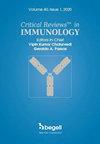Phillygenin alleviated arthritis through the inhibition of NLRP3 inflammasome and Ferroptosis by AMPK
IF 0.9
4区 医学
Q4 IMMUNOLOGY
引用次数: 0
Abstract
Background: We investigated the potential arthritis-inducing effects of Phillygenin and its underlying mechanisms. Methods: RAW264.7 cells were stimulated with lipopolysaccharide to induce inflammation. Results: Phillygenin was found to reduce arthritis score, histopathological changes, paw edema, spleen index, and ALP levels in a dose-dependent manner in a model of arthritis. Additionally, Phillygenin was able to decrease levels of inflammation markers in serum samples of mice with arthritis and also inhibited inflammation markers in the cell supernatant of an in vitro model of arthritis. Phillygenin increased cell viability and JC-1 disaggregation, enhanced calcien-AM/CoCl2, reduced LDH activity levels and IL-1α levels, and inhibited Calcein/PI levels and iron concentration in an in vitro model. Phillygenin was also found to reduce ROS-induced oxidative stress and Ferroptosis, and suppress the NLRP3 inflammasome in both in vivo and in vitro models through AMPK. In the in vivo model, Phillygenin was observed to interact with AMPK protein.Conclusions: These findings suggest that Phillygenin may be a potential therapeutic target for preventing arthritis by inhibiting NLRP3 inflammasome and Ferroptosis through AMPK. This indicates that Phillygenin could have disease-modifying effects on arthritis.菲利根因通过抑制 NLRP3 炎症小体和 AMPK 的铁凋亡缓解关节炎
背景方法:用脂多糖刺激RAW264.7细胞诱发炎症:方法:用脂多糖刺激 RAW264.7 细胞诱发炎症:结果:在关节炎模型中,Phillygenin能以剂量依赖的方式降低关节炎评分、组织病理学变化、爪水肿、脾脏指数和ALP水平。此外,菲利根因还能降低关节炎小鼠血清样本中的炎症标志物水平,并抑制体外关节炎模型细胞上清液中的炎症标志物。在体外模型中,Phillygenin 能提高细胞活力和 JC-1 分解,增强钙离子-AM/CoCl2,降低 LDH 活性水平和 IL-1α 水平,抑制 Calcein/PI 水平和铁浓度。研究还发现,在体内和体外模型中,Phillygenin 还能通过 AMPK 减少 ROS 诱导的氧化应激和铁氧化,并抑制 NLRP3 炎性体。在体内模型中,观察到菲利根因与 AMPK 蛋白相互作用:这些研究结果表明,Phillygenin 可通过 AMPK 抑制 NLRP3 炎性体和铁氧化酶,从而成为预防关节炎的潜在治疗靶点。结论:这些研究结果表明,Phillygenin 可通过 AMPK 抑制 NLRP3 炎症蛋白酶体和铁氧化酶,从而成为预防关节炎的潜在治疗靶点。
本文章由计算机程序翻译,如有差异,请以英文原文为准。
求助全文
约1分钟内获得全文
求助全文
来源期刊
CiteScore
2.60
自引率
0.00%
发文量
14
审稿时长
>12 weeks
期刊介绍:
Immunology covers a broad spectrum of investigations at the genes, molecular, cellular, organ and system levels to reveal defense mechanisms against pathogens as well as protection against tumors and autoimmune diseases. The great advances in immunology in recent years make this field one of the most dynamic and rapidly growing in medical sciences. Critical ReviewsTM in Immunology (CRI) seeks to present a balanced overview of contemporary adaptive and innate immune responses related to autoimmunity, tumor, microbe, transplantation, neuroimmunology, immune regulation and immunotherapy from basic to translational aspects in health and disease. The articles that appear in CRI are mostly obtained by invitations to active investigators. But the journal will also consider proposals from the scientific community. Interested investigators should send their inquiries to the editor before submitting a manuscript.

 求助内容:
求助内容: 应助结果提醒方式:
应助结果提醒方式:


